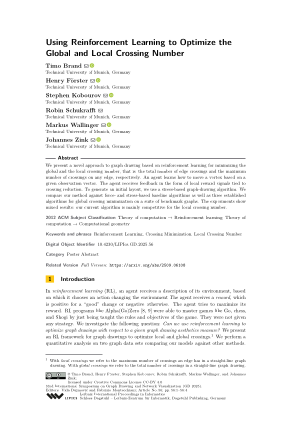Using Reinforcement Learning to Optimize the Global and Local Crossing Number (Poster Abstract)
Authors
Timo Brand  ,
Henry Förster
,
Henry Förster  ,
Stephen Kobourov
,
Stephen Kobourov  ,
Robin Schukrafft,
Markus Wallinger
,
Robin Schukrafft,
Markus Wallinger  ,
Johannes Zink
,
Johannes Zink 
-
Part of:
Volume:
33rd International Symposium on Graph Drawing and Network Visualization (GD 2025)
Part of: Series: Leibniz International Proceedings in Informatics (LIPIcs)
Part of: Conference: Graph Drawing and Network Visualization (GD) - License:
 Creative Commons Attribution 4.0 International license
Creative Commons Attribution 4.0 International license
- Publication Date: 2025-11-26
File

PDF
LIPIcs.GD.2025.56.pdf
- Filesize: 4.89 MB
- 4 pages
Document Identifiers
Related Versions
- Full Version https://arxiv.org/abs/2509.06108
Subject Classification
ACM Subject Classification
- Theory of computation → Reinforcement learning
- Theory of computation → Computational geometry
Keywords
- Reinforcement Learning
- Crossing Minimization
- Local Crossing Number
Metrics
- Access Statistics
-
Total Accesses (updated on a weekly basis)
0PDF Downloads0Metadata Views
Abstract
We present a novel approach to graph drawing based on reinforcement learning for minimizing the global and the local crossing number, that is, the total number of edge crossings and the maximum number of crossings on any edge, respectively. An agent learns how to move a vertex based on a given observation vector. The agent receives feedback in the form of local reward signals tied to crossing reduction. To generate an initial layout, we use a stress-based graph-drawing algorithm. We compare our method against force- and stress-based baseline algorithms as well as three established algorithms for global crossing minimization on a suite of benchmark graphs. The experiments show mixed results: our current algorithm is mainly competitive for the local crossing number.
Cite As Get BibTex
Timo Brand, Henry Förster, Stephen Kobourov, Robin Schukrafft, Markus Wallinger, and Johannes Zink. Using Reinforcement Learning to Optimize the Global and Local Crossing Number (Poster Abstract). In 33rd International Symposium on Graph Drawing and Network Visualization (GD 2025). Leibniz International Proceedings in Informatics (LIPIcs), Volume 357, pp. 56:1-56:4, Schloss Dagstuhl – Leibniz-Zentrum für Informatik (2025)
https://doi.org/10.4230/LIPIcs.GD.2025.56
BibTex
@InProceedings{brand_et_al:LIPIcs.GD.2025.56,
author = {Brand, Timo and F\"{o}rster, Henry and Kobourov, Stephen and Schukrafft, Robin and Wallinger, Markus and Zink, Johannes},
title = {{Using Reinforcement Learning to Optimize the Global and Local Crossing Number}},
booktitle = {33rd International Symposium on Graph Drawing and Network Visualization (GD 2025)},
pages = {56:1--56:4},
series = {Leibniz International Proceedings in Informatics (LIPIcs)},
ISBN = {978-3-95977-403-1},
ISSN = {1868-8969},
year = {2025},
volume = {357},
editor = {Dujmovi\'{c}, Vida and Montecchiani, Fabrizio},
publisher = {Schloss Dagstuhl -- Leibniz-Zentrum f{\"u}r Informatik},
address = {Dagstuhl, Germany},
URL = {https://drops.dagstuhl.de/entities/document/10.4230/LIPIcs.GD.2025.56},
URN = {urn:nbn:de:0030-drops-250420},
doi = {10.4230/LIPIcs.GD.2025.56},
annote = {Keywords: Reinforcement Learning, Crossing Minimization, Local Crossing Number}
}
Author Details
References
- Rome graphs. URL: http://graphdrawing.org/data.html.
- Reyan Ahmed, Felice De Luca, Sabin Devkota, Stephen Kobourov, and Mingweiahmed2022multicriteria Li. Multicriteria scalable graph drawing via stochastic gradient descent, (SGD)². IEEE Trans. Vis. Comput. Graph., 28(6):2388-2399, 2022. URL: https://doi.org/10.1109/TVCG.2022.3155564.
- Réka Albert and Albert-László Barabási. Topology of evolving networks: local events and universality. Physical review letters, 85(24):5234, 2000. URL: https://doi.org/10.1103/physrevlett.85.5234.
- Tomihisa Kamada and Satoru Kawai. An algorithm for drawing general undirected graphs. Information Processing Letters, 31(1):7-15, 1989. URL: https://doi.org/10.1016/0020-0190(89)90102-6.
-
Maximilian Pfister. Personal communication, 2025.

- Marcel Radermacher, Klara Reichard, Ignaz Rutter, and Dorothea Wagner. Geometric heuristics for rectilinear crossing minimization. J. Exp. Algorithmics, 24:1-21, 2019. URL: https://doi.org/10.1145/3325861.
- Ilkin Safarli, Youjia Zhou, and Bei Wang. Interpreting graph drawing with multi-agent reinforcement learning. CoRR, abs/2011.00748, 2020. URL: https://arxiv.org/abs/2011.00748.
- David Silver, Thomas Hubert, Julian Schrittwieser, Ioannis Antonoglou, Matthew Lai, Arthur Guez, Marc Lanctot, Laurent Sifre, Dharshan Kumaran, Thore Graepel, Timothy Lillicrap, Karen Simonyan, and Demis Hassabis. A general reinforcement learning algorithm that masters chess, shogi, and Go through self-play. Science, 362(6419):1140-1144, 2018. URL: https://doi.org/10.1126/science.aar6404.
- David Silver, Julian Schrittwieser, Karen Simonyan, Ioannis Antonoglou, Aja Huang, Arthur Guez, Thomas Hubert, Lucas Baker, Matthew Lai, Adrian Bolton, Yutian Chen, Timothy P. Lillicrap, Fan Hui, Laurent Sifre, George van den Driessche, Thore Graepel, and Demis Hassabis. Mastering the game of Go without human knowledge. Nature, 550(7676):354-359, 2017. URL: https://doi.org/10.1038/NATURE24270.
- Xiaoqi Wang, Kevin Yen, Yifan Hu, and Han-Wei Shen. SmartGD: A GAN-based graph drawing framework for diverse aesthetic goals. IEEE Trans. Vis. Comput. Graph., 30(8):5666-5678, 2023. URL: https://doi.org/10.1109/TVCG.2023.3306356.
